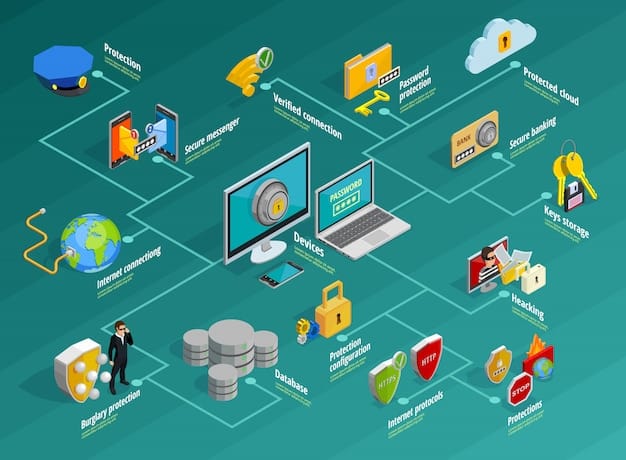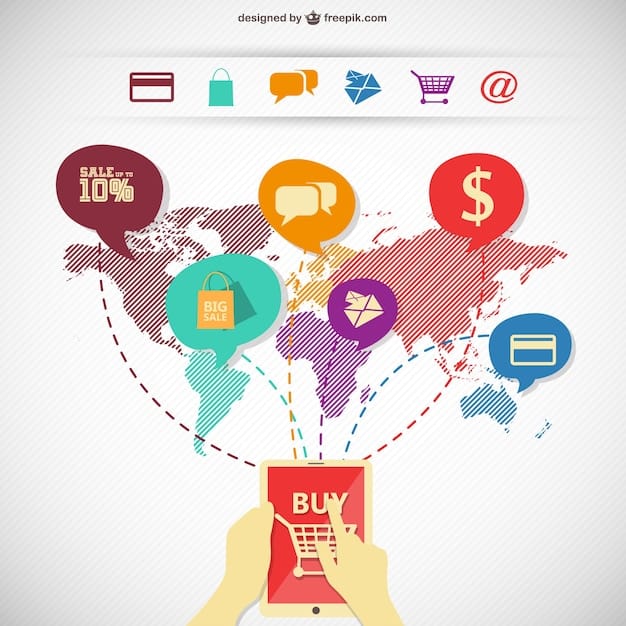Cross-Border Payments in 2025: A Guide for US E-commerce

Cross-border payments for US e-commerce in 2025 require navigating currency conversion complexities and evolving international regulations to ensure seamless, compliant transactions and enhanced customer experiences, which can be achieved through strategic planning and embracing technological advancements.
Are you ready to expand your US e-commerce business globally? In 2025, navigating the landscape of cross-border payments will be crucial for success. This article provides a comprehensive guide to understanding currency conversion, international regulations, and best practices for seamless global transactions.
Understanding the Evolving Landscape of Cross-Border E-commerce
The world of e-commerce is rapidly expanding, and US businesses are increasingly looking to international markets for growth. However, with this expansion comes the challenge of navigating the complexities of cross-border payments. In 2025, understanding these complexities will be more critical than ever.
The shift towards globalization has made it essential for US e-commerce businesses to accept payments in multiple currencies and comply with various international regulations. Staying ahead requires businesses to adapt and evolve their payment strategies.
Key Factors Driving the Growth of Cross-Border E-commerce
* **Expanding Global Reach:** E-commerce platforms now facilitate access to markets previously out of reach, allowing US businesses to tap into new customer bases.
* **Increased Consumer Demand:** Consumers worldwide are increasingly comfortable making online purchases from international vendors, driving demand for seamless cross-border transactions.
* **Technological Advancements:** Innovations in payment technology have made cross-border payments faster, more secure, and more efficient.
Challenges in Navigating Cross-Border Payments
* **Currency Conversion:** Fluctuating exchange rates can impact profitability, necessitating strategies for managing currency risk.
* **International Regulations:** Compliance with diverse regulatory frameworks, such as GDPR and local tax laws, is essential for avoiding legal issues.
* **Payment Methods:** Different regions prefer different payment methods, requiring businesses to offer a variety of options to cater to local preferences.
Understanding these factors and challenges is the first step in successfully navigating the world of cross-border payments. Adapting to the evolving landscape will enable US e-commerce businesses to thrive in the global market.

Currency Conversion Strategies for US E-commerce Businesses
Currency conversion is a fundamental aspect of cross-border payments. Effectively managing currency conversion can significantly impact the profitability and competitiveness of US e-commerce businesses.
The goal is to minimize the costs associated with currency exchange while providing customers with transparent and fair pricing. Businesses need to adopt strategies that balance cost-effectiveness with customer satisfaction.
Managing Currency Fluctuations
* **Real-Time Exchange Rates:** Integrating real-time exchange rates into your payment system ensures accurate pricing and minimizes discrepancies.
* **Hedging Strategies:** Employing hedging strategies, such as forward contracts, can protect against adverse currency movements.
* **Dynamic Currency Conversion (DCC):** DCC allows customers to pay in their local currency, providing transparency and convenience.
Choosing the Right Conversion Method
* **Bank Transfers:** Traditional bank transfers can be reliable but often come with higher fees and slower processing times.
* **Online Payment Platforms:** Services like PayPal and Stripe offer competitive exchange rates and streamlined payment processing.
* **Specialized Currency Exchange Services:** These services may provide better rates for large transactions but require more complex integration.
By implementing robust currency conversion strategies, US e-commerce businesses can mitigate risks, optimize costs, and enhance customer trust. Keeping abreast of market trends and technological advancements in currency exchange will be essential for maintaining a competitive edge.
Navigating International Payment Regulations in 2025
International payment regulations are complex and constantly evolving. For US e-commerce businesses, staying compliant with these regulations is crucial to avoid legal issues and maintain customer trust when dealing with cross-border payments.
Compliance goes beyond just adhering to laws; it involves understanding the nuances of different regulatory frameworks and adapting business practices accordingly. The cost of non-compliance can be significant, ranging from fines to reputational damage.
Key Regulatory Frameworks to Be Aware Of
* **General Data Protection Regulation (GDPR):** GDPR governs the processing of personal data of individuals within the European Union. US businesses must ensure compliance when dealing with EU customers.
* **Payment Card Industry Data Security Standard (PCI DSS):** PCI DSS sets security standards for handling credit card information. Compliance is essential to protect customer data and prevent fraud.
* **Anti-Money Laundering (AML) Regulations:** AML regulations aim to prevent financial crimes by requiring businesses to implement due diligence measures and report suspicious transactions.
Strategies for Ensuring Compliance
* **Due Diligence:** Conduct thorough due diligence on payment processors and partners to ensure they comply with relevant regulations.
* **Data Protection:** Implement robust data protection measures, including encryption and access controls, to safeguard customer data.
* **Compliance Training:** Provide regular training to employees on compliance requirements and best practices.
Successfully navigating international payment regulations requires a proactive and informed approach. US e-commerce businesses should invest in compliance resources and seek expert advice to stay ahead of regulatory changes.

Best Practices for Secure Cross-Border Transactions
Security is a paramount concern in cross-border payments. US e-commerce businesses must implement robust security measures to protect customer data and prevent fraud.
The consequences of security breaches can be devastating, leading to financial losses, reputational damage, and legal liabilities. A proactive approach to security is essential for maintaining customer trust and ensuring business continuity.
Implementing Advanced Security Measures
* **Tokenization:** Replace sensitive payment data with non-sensitive tokens to protect against data breaches.
* **Encryption:** Use encryption to secure data transmission and storage, both in transit and at rest.
* **Two-Factor Authentication (2FA):** Implement 2FA to add an extra layer of security to customer accounts and payment transactions.
Fraud Prevention Strategies
* **Fraud Detection Systems:** Utilize fraud detection systems to identify and prevent fraudulent transactions in real-time.
* **Address Verification System (AVS):** AVS verifies the billing address provided by the customer with the address on file with the credit card issuer.
* **3D Secure Authentication:** 3D Secure adds an extra layer of authentication to online transactions, reducing the risk of fraud.
By adopting these best practices, US e-commerce businesses can create a secure payment environment, protect customer data, and mitigate the risk of fraud. Continuous monitoring and adaptation to emerging threats are essential for maintaining a strong security posture.
The Role of Technology in Streamlining Cross-Border Payments
Technology plays a pivotal role in streamlining cross-border payments. US e-commerce businesses can leverage innovative technologies to improve efficiency, reduce costs, and enhance customer experience.
The right technology solutions can automate many of the complex processes involved in cross-border payments, freeing up resources and allowing businesses to focus on core operations. Staying abreast of technological advancements is crucial for maintaining a competitive edge.
Emerging Technologies Transforming Cross-Border Payments
* **Blockchain Technology:** Blockchain offers secure and transparent payment processing, reducing intermediaries and lowering transaction costs.
* **Artificial Intelligence (AI):** AI-powered solutions can automate fraud detection, improve currency conversion rates, and personalize customer experience.
* **APIs (Application Programming Interfaces):** APIs facilitate seamless integration between different payment systems, enabling faster and more efficient transactions.
Choosing the Right Technology Solutions
* **Scalability:** Select technology solutions that can scale to meet the growing needs of your business.
* **Integration:** Ensure that the chosen solutions integrate seamlessly with your existing systems and processes.
* **Security:** Prioritize security when selecting technology solutions, ensuring they comply with industry standards and best practices.
Embracing technology can significantly streamline cross-border payments, making them faster, more secure, and more cost-effective. US e-commerce businesses should invest in innovative solutions to stay ahead of the competition.
Preparing for 2025: Future Trends in Cross-Border Payments
Looking ahead to 2025, several key trends are set to shape the future of cross-border payments. US e-commerce businesses need to anticipate these trends and prepare accordingly to maintain a competitive advantage.
The future of cross-border payments will be driven by technological innovation, regulatory changes, and evolving customer expectations. Businesses that proactively adapt to these trends will be best positioned for success.
Key Trends to Watch For
* **Increased Use of Mobile Payments:** Mobile payments are becoming increasingly popular worldwide, driven by the proliferation of smartphones and mobile wallets.
* **Growing Adoption of Alternative Payment Methods:** Alternative payment methods, such as digital wallets, local payment schemes, and cryptocurrencies, are gaining traction in various markets.
* **Enhanced Focus on Customer Experience:** Customers increasingly expect seamless and personalized payment experiences. Businesses need to focus on providing convenient and frictionless payment options.
Strategies for Staying Ahead
* **Invest in Technology:** Invest in innovative payment technologies to improve efficiency and enhance customer experience.
* **Stay Informed:** Stay informed about regulatory changes and emerging trends in the cross-border payments landscape.
* **Adapt Your Strategies:** Be prepared to adapt your payment strategies to meet changing customer expectations and market conditions.
By anticipating these future trends and implementing proactive strategies, US e-commerce businesses can successfully navigate the evolving landscape of cross-border payments in 2025 and beyond.
| Key Aspect | Brief Description |
|---|---|
| 🌍 Global Reach | Expanding markets for US e-commerce businesses via international transactions. |
| ⚖️ Regulations | Complying with GDPR, PCI DSS, and AML for legal and secure operations. |
| 🔒 Security | Implementing tokenization, encryption, and 2FA to prevent fraud. |
| 📱 Mobile Payments | Growing trend demanding seamless mobile payment options for customers. |
FAQ Section
▼
Key challenges include currency conversion, compliance with international regulations (like GDPR and PCI DSS), and offering various payment methods preferred by different regions.
▼
Businesses can use real-time exchange rates, employ hedging strategies like forward contracts, and offer Dynamic Currency Conversion (DCC) to customers.
▼
Implementing tokenization, encryption, two-factor authentication (2FA), and using fraud detection systems are crucial for secure transactions and data protection.
▼
Blockchain, AI, and APIs optimize payment processing, enhance currency conversion, automate fraud detection, and facilitate seamless integration between different payment systems.
▼
Businesses should anticipate the increased use of mobile payments, growing adoption of alternative payment methods, and enhanced focus on providing seamless customer experiences.
Conclusion
Successfully navigating cross-border payments for US e-commerce in 2025 requires a strategic and informed approach. By understanding the evolving landscape, implementing robust security measures, and embracing innovative technologies, US businesses can seize global opportunities and achieve sustainable growth.





